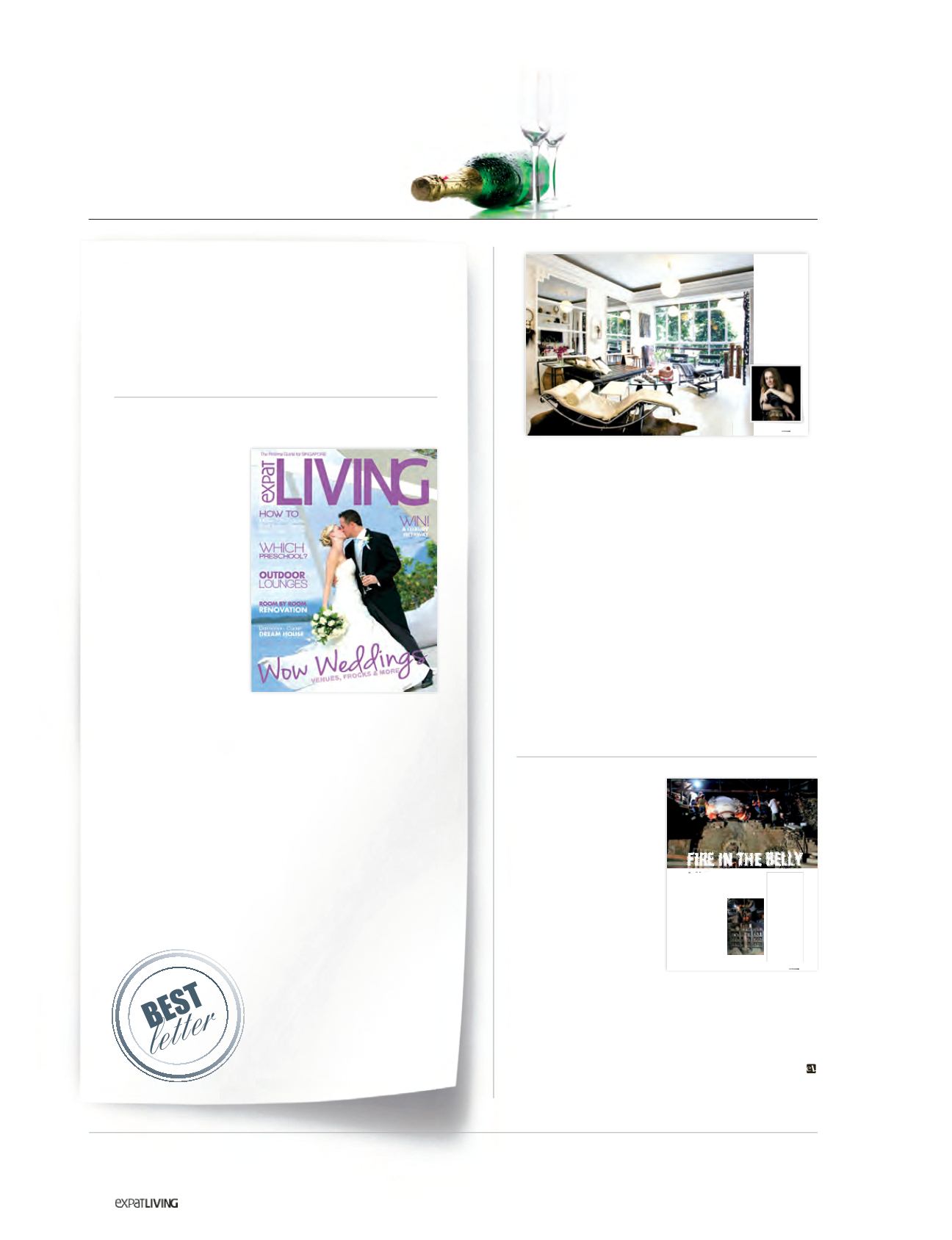

38
February15
Email us at
info@expatliving.sgBest Letter
We want to hear from you! Send us your thoughts on
the magazine, or on any subject under the sun. For
telling us how
Expat Living
helped her arrange her
wedding and set up home in Singapore,
Grace Wee
wins a bottle of champagne.
Home from Home
Paul and I moved from
London to Singapore
for his work a couple
of years ago, which
happened to coincide
with the time when
we were planning to
get married and set
up home together.
The first
Expat Living
that caught my eye
was the June 2012
edition; it had a
special feature on
getting married in Singapore, with a lot of helpful advice
and recommendations.
When we found our new home, we used your
magazine for ideas and inspiration on furniture and
décor – from outdoor furniture to dining tables and more.
Now that we’re completely settled in, we’re absolutely
loving our new home. Looking at our flat this evening,
I realised how much of it has been inspired by your
articles and suggestions, and how
Expat Living
has
touched our lives over the past two years.
We would like to take this opportunity to say a big
thank you to your editorial team for a job that is truly
well done!
Grace Wee
Ed: Thank you for your lovely
email. It’s very important
to us to know that we are
helping people settle in
and create a home they’re
happy in!
Holiday Spirit
I read your interview with photographer Carolyn
Strover in the January 2015 issue and found one of
Carolyn’s comments to be quite inspirational. She
said: “Despite having so much on my shoulders,
despite being so busy with my work and children,
there’s a small part of me that feels I’m on holiday
every day.”
I know of very few women who would share this
sentiment when they have three kids to raise single-
handedly and a full-time career. Personally, the only
time I’ve felt on holiday was when I was on holiday!
I must commend Carolyn on her work and on her
positive spirit. Keep it up, Carolyn!
Priyanka Dasgupta
Roaring Success
I simply loved “Fire in
the Belly”, your January
2015 article by Katie
Rober ts about the
dragon kiln at Jungle
Pottery. Though I’d
visited the place before
and even bought a
few well-priced plant
pots from the massive
warehouse, I never really grasped the artistic and
cultural significance of the kiln itself.
It’s also encouraging to know that interest in the
dragon kiln has been revived in tandem with a revival
of ceramic art in Singapore. Long may it continue!
Victoria Thomas
LETTERS
Readers’ thoughts and
comments about
EL
STUDIOSHOWCASE
HOME
49
48
January15
January15
CAROLYN STROVER is an
interestingmix – third culture kid
(TKC), professional photographer
and singlemother of three swave-
boarding teens.
VerneMaree
met
upwithherat theBotanicGardens
apartment that isalsoher studio.
FORM
FOLLOWS
FUNCTION
PhotographybyCarolynStrover
POTTERY
133
January15
Historyof thekiln
Built in 1940, Thow Kwang
was based on a traditional
Chinesedesign thatdatesback
thousands of years. It was one
of up to 20 kilns that produced
the clay latex cups used in the
rubber plantations that were
dotted around the island. Local
white clay was freely available
in the area. As the plantations
closed, demand for the cups
waned, so the kilns turned to
making ceramic pots. When
demand forpotsdropped,many
of the kilns closed.But a revival
in the community’s interest in
potting in the early 2000s saw
two kilnsgaspback to life.
Yulianti Tan’s father-in-law
bought thekiln in1965,and she
nowoperates itwithherhusband.
Shehasbeeneducatingpeople
about the kiln for 16 years and
raising awareness, particularly
among young people, about
pottery-making, thekiln’sheritage
and culture, and the unique
effects that come from firing in
thedragonkiln.
T
how Kwang is one of two
surviving dragons kilns in
Singapore; both are in the
same street, owing to their
proximity to the white clay that was
once used on site. Known colloquially
as Jungle Pottery, Thow Kwang’s lush
and spacious grounds have formany
years been home to a one-stop shop
for ceramicpots, lamps, tableware and
more.What’s not sowell known is the
significance and provenance of the
historic dragon kiln thatwas once part
of a flourishing ceramics industry. It’s
nowat thecentreofa revival inceramic
arton the island.
Last year, the leases of both Thow
Kwang and neighbouring Guan Huat
kiln were renewed for nine years after
an active campaign to protect their
heritagevalue fromurbanencroachment.
The local and international artistic
communities are now drawn to Thow
You’dbe forgiven for thinkingSingapore’shistory is fastdisappearing
underanavalancheofseeminglyendlessconstruction.However, there
arehidden treasures tobediscovered inout-of-the-waypocketsof the
islandwhichhaveescaped thebulldozers.An irreplaceablegem is the
70-year-old “dragonkiln”atThowKwangPotteryJunglenearJurong.
KATIEROBERTSspoke to twoceramicartistsabout thekiln’sunique
charmand itspower tobringpeople together.
Top:
Gently loadingwood into stokeholes
Above:
The kilnopenandphographed
beforeunpacking



















